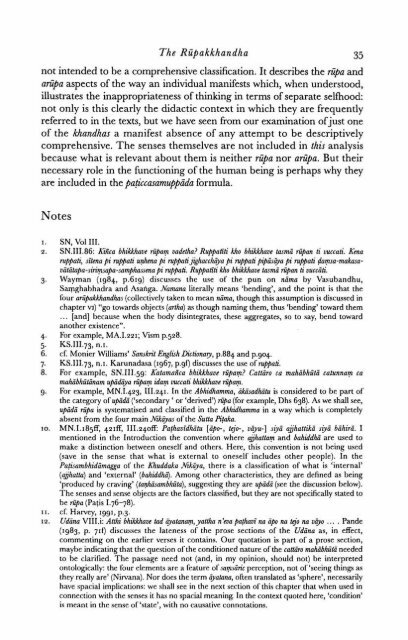Identity and Experience_Hamilton_1996
Identity and Experience_Hamilton_1996
Identity and Experience_Hamilton_1996
You also want an ePaper? Increase the reach of your titles
YUMPU automatically turns print PDFs into web optimized ePapers that Google loves.
The Rtipakkh<strong>and</strong>ha<br />
not intended to be a comprehensive classification. It describes the riipa <strong>and</strong><br />
arzipa aspects of the way an individual manifests which, when understood,<br />
illustrates the inappropriateness of thinking in terms of separate selfhood:<br />
not only is this clearly the didactic context in which they are frequently<br />
referred to in the texts, but we have seen from our examination ofjust one<br />
of the kh<strong>and</strong>has a manifest absence of any attempt to be descriptively<br />
comprehensive. The senses themselves are not included in this analysis<br />
because what is relevant about them is neither rzipa nor ariipa. But their<br />
necessary role in the functioning of the human being is perhaps why they<br />
are included in the paficcasarnuppida formula.<br />
Notes<br />
SN, Vol 111.<br />
SN.III.86: K&a bhikkhave nipam vadetha? Ruizpatiti kho bhikkhave tasmii riipan ti vuccati. Kina<br />
mjpati, sftcna pi ruppati u$ma pi mf@ati jghatchqa pi nrpiati piprSga pi Wati dawa-makasaviitiitapa-sin'wapa-~amphascnza<br />
pi ruppati. Ruppatiti kho bhikWlave tasmii nipan ti vucciiti.<br />
Wayman (1984, p.619) discusses the use of the pun on niima by Vasub<strong>and</strong>hu,<br />
Saghabhadra <strong>and</strong> Asaliga. Namana literally means 'bending', <strong>and</strong> the point is that the<br />
four ariipakkh<strong>and</strong>has (collectively taken to mean niima, though this assumption is discussed in<br />
chapter vr) "go towards objects (artha) as though naming them, thus 'bending' toward them<br />
. . . [<strong>and</strong>] because when the body disintegrates, these aggregates, so to say, bend toward<br />
another existence".<br />
For example, MA.1.221; Vism p.528.<br />
KS.III.73, n.1.<br />
cf Monier Williams' Sanskrit Englkh Dictiona~, p.884 <strong>and</strong> p.904.<br />
KS.III.73, n.1. Karunadasa (1967, p.gf) discusses the use ofruppati.<br />
For example, SN.III.59: Katamafica bhikkhave rCpar.n? Cattiiro ca mahiibhitii catunnam ca<br />
mahiibhltiinam upidiija nipam idam vuccati bhikkhave nipam.<br />
For example, MN.I.423, 111.241. In the Abhidhamma, CrkiisadhZtu is considered to be part of<br />
the category ofupiidi ('secondary ' or 'derived') nipa (for example, Dhs 638). As we shall see,<br />
upiidii nips is systematised <strong>and</strong> classified in the Abhid/zamma in a way which is completely<br />
absent fi-om the fbur main flikiijas of'the Sutta Pitaka.<br />
MN.I.185ff, 42rff, III.2qoff: Pa{havidIzZtu [ipo-, tejo-, vlT;yu-] s+ii ajhattikii s+ii biihirii. I<br />
mentioned in the Introduction the convention where ajhattam <strong>and</strong> bahiddhii are used to<br />
make a distinction between oneself' <strong>and</strong> others. Here, this convention is not being used<br />
(save in the sense that what is external to oneself' includes other people). In the<br />
Patisambhidiimagga of' the Khuddaka Nikqa, there is a classification of what is 'internal'<br />
(ajhatta) <strong>and</strong> 'external' (bahiddhi). Among other characteristics, they are defined as being<br />
'produced by craving' (taghZsambhiita), suggesting they are upiidii (see the discussion below).<br />
The senses <strong>and</strong> sense objects are the factors classified, but they are not specifically stated to<br />
he nipa (Patis 1.76-78).<br />
cf. Harvey, 1991, p.3.<br />
Udiina VII1.i: Atthi bhikWlaue tad ciyatanam, yattha n'eva pafivi na iipo na tejo nu viiyo . . . . P<strong>and</strong>e<br />
(1983, p. 711) discusses the lateness of the prose sections of' the Udiina as, in effect,<br />
commenting on the earlier verses it contains. Our quotation is part of a prose section,<br />
maybe indicating that the question of the conditioned nature of'the cattiro rnahiibhritii needed<br />
to be clarified. The passage need not (<strong>and</strong>, in my opinion, should not) be interpreted<br />
ontologically: the fbur elements are a feature ofsapsiitic perception, not of 'seeing things as<br />
they really are' (Nirvana). Nor does the term qatuna, often translated as 'sphere', necessarily<br />
have spacial implications: we shall see in the next section ofthis chapter that when used in<br />
connection with the senses it has no spacial meaning: In the context quoted here, 'condition'<br />
is meant in the sense of 'state', with no causative connotations.


